Before the gentle reader complains that the above photos looks nothing like the Occidental Hotel in Buffalo,
it
should be noted that Owen Wister's The Virginian, Horseman of the Plains ends
in 1889 with the
Virginian becoming a partner in the ranch. The original
Occidental, constructed by Charles Buell and A. L. McCray in 1880, was, as depicted in the top photo, a log structure, large portions of
which floated down Clear Creek in the floods of 1895 and 1912. See photos below. The interior walls in the original log structue were
made of muslin through which one could hear the mice playing at night. The muslin dining room walls were painted bright blue.
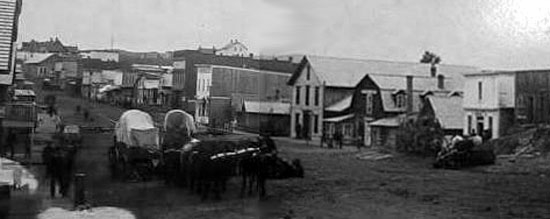
Occidental Hotel across the street from the viewer. The hotel consisted of the original log structure as well as
the two-story gabled building. Photo by Thomas
Dalgleish
To the left of the hotel and to the right of the two one-story structures is Clear Creek. A portion of the foot bridge can
be seen in the photo. The vehicular bridge is concealed by the wagons.
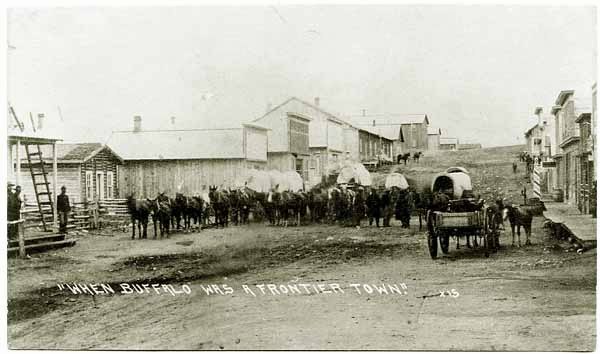
Buffalo, Main Street looking north. Photo by Thomas Dalgleish (attributed)
Thomas Dalgleish was the brother of famed Colorado photographer George Dalgleish. As depicted in the
next set of photos, as the town grew the hotel was expanded and improved over the years.
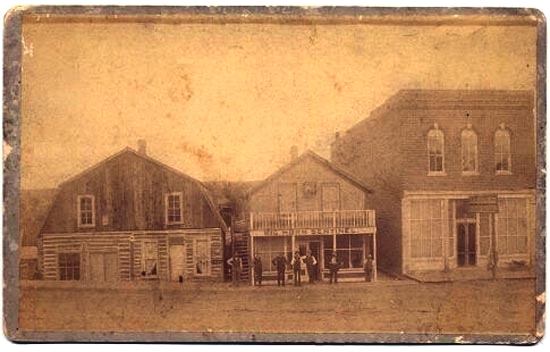
Occidental Hotel on left, Big Horn Sentinel Newspaper in center, 1895, photo by Thomas
Dalgleish
Buffalo, located at the military crossing of the Bozeman Trail across Clear Creek, traces its beginnings to the establishment
of nearby Fort McKinney three miles west of town. The establishment of the
fort brought civilian businesses. Charles Buell, a native of
Wisconsin, also began what become the area's first bank in addition to the Occidental Hotel,
as above noted
featured in Owen Wister's The Virginian.
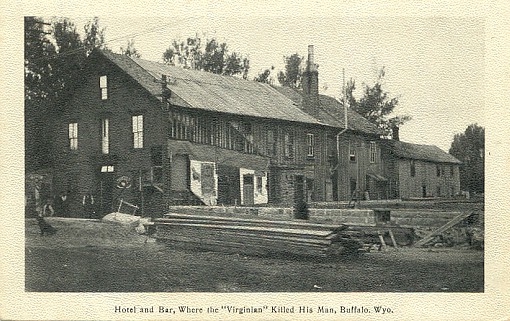
The Occidental, 1902
The present brick and
morter hotel takes up the entire block and dates to additions built in 1903, 1908 and 1910, long
after the Bishop of Wyoming was unsuccessful
in his efforts to dissaude the Virginian from accepting Trampas' challange. Note in the above photo the foundations
of a new addition. See also next photo.
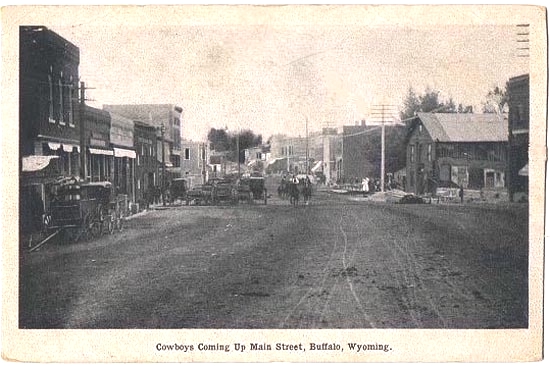
Buffalo, 1902
In constructing the hotel next to Clear Creek, Buell did not take his own advice. In 1879,
prior to the construction of the hotel, August Trabing moved his mercantile
business from its location on Crazy Woman Creek to Buffalo. On the advice
of Buell, Trabing built his mercantile establishment on high ground south of the Creek. Trabing soon sold out to
John A. Conrad and moved to Medicine Bow where he operated another mercantile
business.
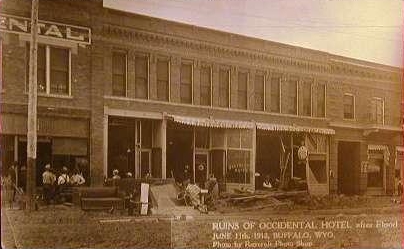
Occidental Hotel after the flood of
June 11, 1912.
Flood has not been the only time the hotel has had its windows broken out. As indicated by the next photo,
other mishaps have occurred.

Front of Occidental Hotel, June 2005. Photo by Geoff Dobson.
On the morning of the day that the above photo was taken, a deer, perhaps in need of a nightcap, entered the bar of
the hotel through the glass door and departed through the large plate glass window.
The Hotel claims to have had Wm. F. Cody, Theodore Roosevelt, Owen Wister, Wm. T. Sherman and Calamity Jane as guests.
Our present day view of the West of the 1880's has, perhaps, been most influenced by
Roosevelt and Wister whose books and articles were illustrated by their mutual friend Frederic
Remington. Remington, in fact, in his 20's worked as a cowboy in the west before returning to
his native New York.
The town itself is not named after the American bison, but, instead, takes its name from Buffalo, New
York. Allegedly, on Buell's suggestion, the name of the town was selected by lot. As luck would have it,
Will Hart, from Buffalo, put the name of his hometown in the hat and
his slip was drawn. Nor is Buffalo, New York, named after the animal, but instead takes its
name from Buffalo Creek which was named either after an Indian who resided in the area or
by early French trappers beau fleuve "beautiful river."
Buffalo, Wyoming, approx. 1900. Compare left photo to
1960's photo on next page.